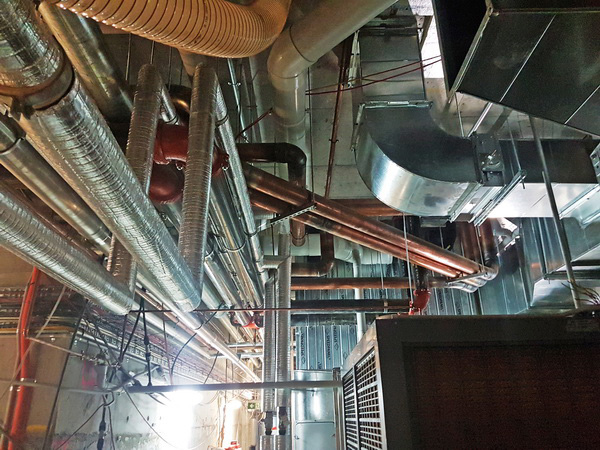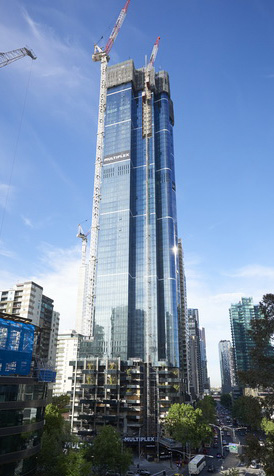
Australia 108 is currently 70 levels high with another 30 levels to go. Photo Multiplex Australasia.
At 321 meters (almost 1,050 feet) and 100-stories high, Melbourne’s new residential super-skyscraper, Australia 108, touches the clouds. It is the tallest residential building in the Southern Hemisphere — and SMACNA member Ellis Air is not only helping to make it a reality, they are helping to make it more viable as well.
“The original proposal for the heating and cooling systems would have been very expensive. We came up with a good alternative offer and saved quite a bit of money for our client,” said Ellis Air’s General Manager Adam Langford of the project. The company is installing the heating and cooling systems hundreds of feet up amid the heat and wind.
Approximately 25 percent of the building’s 1,100 apartments have been completed as construction continues on the top 50 floors of the tower. The construction is scheduled to be completed in two years.
To win the contract, Ellis Air considered the local climate as well as expense. “Summers in Melbourne can be hot, but residents need heating systems in the winter, when temperatures commonly reach four degrees Celsius (39 degrees Fahrenheit),” Langford explained. “We recommended variable refrigerant flow (VRF) units for this project, because they can simultaneously heat and cool and also provided good overall cost savings. VRF is a more energy-efficient design than the original plan, and provides residents with control over their own thermal zones.”

Australia: Ductwork installed by Ellis Air in Level 12 plant room. Photo Ellis Air.
The height of the building, at 100 stories, also presents major challenges. “We’re installing 300-meter long pipework risers down the side of the building,” Langford said. “The design of the pipe anchors and the expansion systems are crucial on a building of this scale — the weight on the pipework at the bottom of the risers is incredible.”
And it’s windy up there. “The height of the building also creates issues with wind pressures,” he reflected, “and a lot of internal testing was performed to ensure that wind effects would not negatively impact the ventilation design.”
“We have 300-millimeter (about 12-inch) pipe going up the whole length of the building and branching out to all 100 floors. There are kilometers of ductwork and over 1,100 indoor air conditioning units,” he noted. “There are hundreds of fans, many pumps, heat exchangers for pressure breaks, cooling towers, gas boilers. The consumables, such as nuts, bolts, and clips, etcetera, would number in the tens of thousands.”
Moving all these materials into place 50 floors and up in the skyscraper takes planning and cooperation. “We use the cranes on-site to lift materials up in cages — but it’s a struggle to get enough time with the cranes. Materials hoists provided by Alimak help make up the difference by letting us work when the cranes are not available.”
Another factor to consider in the construction is the high heat. A killer Australian heat wave is complicating the Australia 108 project. This January temperatures in Melbourne reached 42.8 degrees Celsius (107 degrees Fahrenheit). Australia’s summer falls in December, January, and February.
“We have temperature clauses in our union agreements,” Langford explained. “Employees have to go home if it’s too hot to work safely.” Since 1900, heat waves have killed more Australians than all other natural hazards combined. “The heat has already shut us down four or five times this summer. This cuts into productivity, so we make up the difference in other ways.”
Looking ahead, Langford sees a strong and profitable future for Ellis Air. “Our outlook is good. We have about 15 projects going right now, with locations in Melbourne and Brisbane. With a strong market, getting enough quality people for the job can be a challenge, so we keep an eye out for new opportunities, and look at our staff and areas of expertise to ensure that we have the right people in place for the next project.”
Related Links